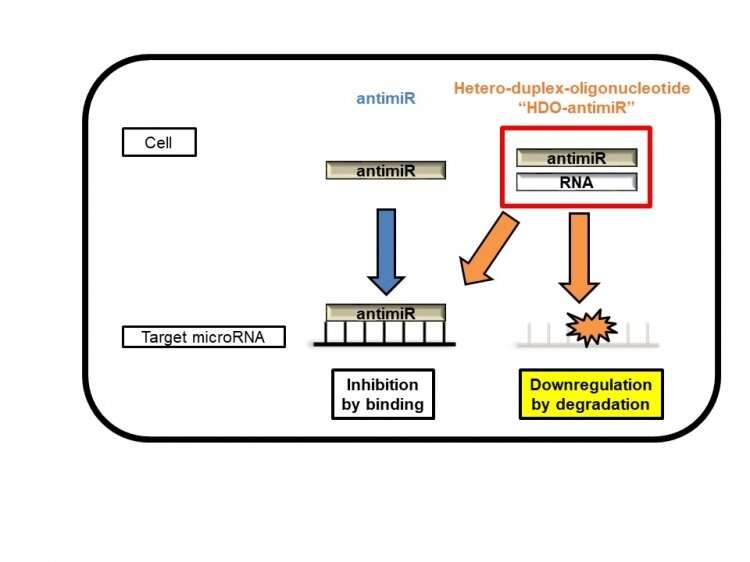HDO-antimiR represents a new weapon in the fight against microRNA-related disease

MicroRNA (miRNA) is a type of RNA that plays an important role in various cellular processes and is also involved in developing defenses against pathogens. Increasing numbers of studies have indicated that certain human diseases are caused by altered expression and organization of miRNA.
Kotaro Yoshioka and Takanori Yokota of Tokyo Medical and Dental University (TMDU) have developed new molecules that can silence or inhibit malfunctioning miRNA, with the hope that their work could lead to new ways to treat diseases which are caused by the miRNAs. Creating a new type of antimiR, which is a molecule that inhibits miRNA, could provide the foundation for new gene therapies.
Yoshioka and Yokota recently developed a new type of antimiR with heightened efficacy against miRNA and lowered toxicity, using their original technique, hetero duplex oligonucleotides (HDO). They combined an antimiR with its complementary RNA to produce a new molecule, termed "HDO-antimiR". They then characterized HDO-antimiR—specifically, they evaluated its strength in inhibiting miRNA, assessed its biological distribution, and checked its specific action by modifying its structure in mice. They recently published their findings in Nucleic Acids Research.
"HDO-antimiR has a unique double-strand structure that is totally different from previously described antimiRs," corresponding author Yokota says. "This structure is responsible for a substantial increase in the potency of miRNA silenced by HDO-antimiR compared with the single-stranded parent antimiR."

The researchers found that compared with conventional antimiR, HDO-antimiR was 12 times as efficient in terms of binding to targeted miRNA, and had improved potency within cells. Further, HDO-antimiR produced enhanced phenotypic effects in mice, specifically increasing the expression of mRNA that targets miRNA, leading to greater miRNA inhibition.
The heightened potency of HDO-antimiR was not related to high bio-stability or an increased rate of delivery to the targeted cell. Although these are common explanations for increased potency, in this case it was a reflection of improved strength once the molecule had entered the cells. This indicates that the unique structure of HDO-antimiR enabled it to behave differently than other types of miRNA inhibitors.
More information: Kotaro Yoshioka et al, Highly efficient silencing of microRNA by heteroduplex oligonucleotides, Nucleic Acids Research (2019). DOI: 10.1093/nar/gkz492
Journal information: Nucleic Acids Research
Provided by Tokyo Medical and Dental University





















